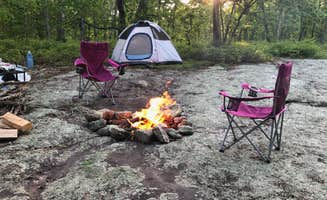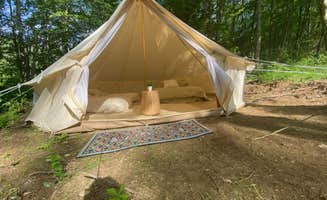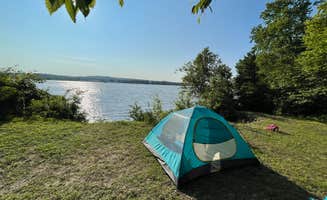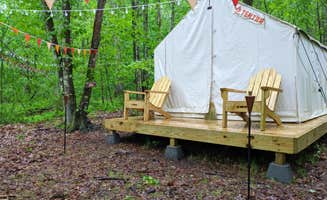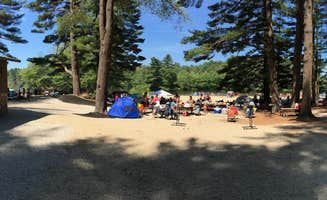Tent camping opportunities near North Stonington, Connecticut extend beyond established campgrounds to include several unique wilderness settings within 30 miles. The region features multiple waterfront camping options along the Connecticut River, while inland sites provide access to over 14,000 acres of forested wilderness in the Arcadia Management Area. Summer temperatures typically range from 65-85°F, with cooler spring and fall seasons requiring additional preparation for overnight stays.
What to do
Water recreation access: Gillette Castle State Park Campground offers direct access to the Connecticut River where campers can swim and fish throughout their stay. The riverfront location provides convenient water entry points near tent sites. "We have camped on the south end of Hurd Park several times via boat access. It is amazing with the views of the CT River and being able to watch the sunrise and sunset," reports Jackie G.
Hiking opportunities: Hidden Lake Farm features five tent sites with access to walking trails through wooded areas. The property maintains private hiking paths through mixed hardwood forest. Ashley F. describes the experience as "Quiet and Private," noting the peaceful setting away from crowded park areas.
Wildlife viewing: Tent campers at Selden Neck State Park Campground regularly spot river otters, osprey, and bald eagles from their campsites. The island's undeveloped status creates a natural habitat for numerous wildlife species. During low tide, small beaches emerge where campers can observe shoreline wildlife and aquatic species.
What campers like
Sunrise and sunset views: Gillette Castle State Park Campground receives high marks for its dramatic sky views over the Connecticut River. The eastern exposure provides exceptional morning light conditions while western views showcase evening colors. Todd J. notes it's a "Great place for a hike or a picnic" with castle tours available during specified hours.
Isolation from crowds: Many campers value the secluded nature of sites in the region. Chapman Pond Preserve offers walk-in sites that provide significant privacy from other campers and day visitors. Ben L. describes it as a "Middle of no where site" with "Good tent platforms, picnic tables and outhouse. CT river within view."
Beach access: Several riverfront camping locations feature small sand beaches that emerge during low tide. These provide natural play areas for children and convenient fishing access. Water levels fluctuate approximately 3-4 feet between high and low tides, creating changing shoreline conditions throughout the day.
What you should know
Water transportation requirements: Selden Neck State Park Campground is only accessible by boat, requiring campers to launch from designated areas and paddle to the island. Jason S. advises: "It's about a 20 minute paddle across the river to the island. If it's a nice day, you're going to encounter some wake from passing boats so make sure your gear is in waterproof bags."
Weather considerations: Morning fog frequently develops over the Connecticut River, potentially delaying departures from island and riverside campsites. This typically burns off by mid-morning but can impact early departure plans. Water temperatures remain cool (below 70°F) until late June in most areas.
Permit requirements: Several boat launches require parking permits during peak season from Memorial Day through Labor Day. These must be arranged in advance through the Connecticut Department of Energy and Environmental Protection website or by phone. Weekend availability becomes limited by mid-May.
Tips for camping with families
Safety planning: When camping with children near water, establish clear boundaries around river access areas. Designate specific swimming zones within sight of the campsite. The current strength in the Connecticut River varies by location, with calmer waters found in protected coves.
Activity preparation: Chapman Pond Preserve offers good tent platforms that provide stable sleeping surfaces for younger campers. The site includes established areas for family activities with views of the Connecticut River. Pack field guides for identifying local wildlife as educational activities.
Campsite selection: Choose sites with natural boundaries for younger children. Many riverside campsites have clearly defined edges that help contain play areas. Frosty Hollow Camping Area provides tent sites with natural terrain features that create defined camping spaces away from hazards.
Tips from RVers
Alternative arrangements: Though RV access is limited at most primitive sites, Arcadia Backpack Camping Area provides access to tent sites that can be reached after parking larger vehicles in designated areas. The camping area connects to an extensive trail system suitable for day hiking while maintaining a base camp.
Equipment transport: For boat-in tent sites, consider equipment limitations carefully. Most paddlers can transport 40-50 pounds of camping gear per kayak, requiring multiple trips for larger groups. Waterproof storage is essential for all clothing and sleeping gear when accessing island campsites.


